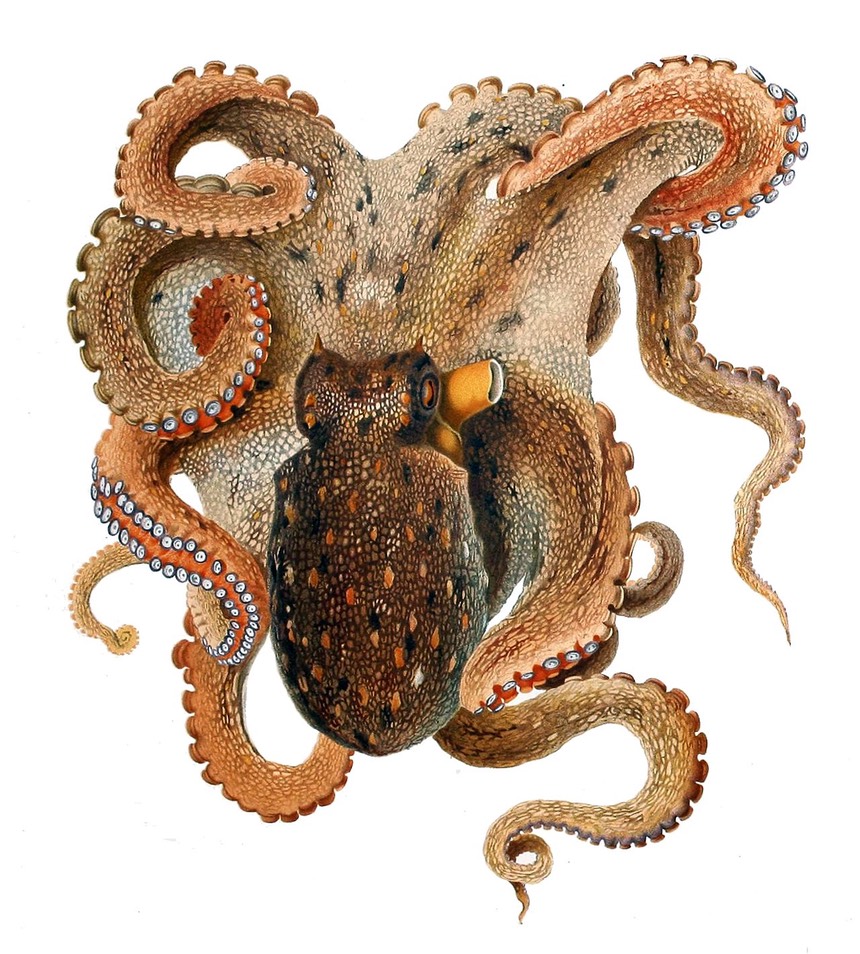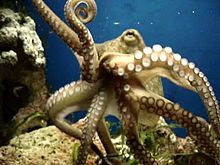Recent video: of deep sea octopuses
Octopuses 🐙 are a soft-bodied, eight-limbed molluscs of the order Octopoda. Around 300 species are recognised, and the order is grouped within the class Cephalopoda with squids, cuttlefish, and nautiloids.

Illustration of a common octopus (Vulgaris) Comingio Merculiano (1845-1915) in Jatta Giuseppe (1860-1903). image: wikimedia.org
Like other cephalopods, octopuses are bilaterally symmetric with two eyes and a beak, with its mouth at the center point of the eight limbs (traditionally called "arms", sometimes mistakenly called "tentacles").

Diagram of octopus from side, with gills, funnel, eye, ocellus (eyespot), web, arms, suckers, hectocotylus and ligula labelled. image: NOAA Technical Report NMFS 73/wikipedia
Adaptable body form and intelligence
Their soft body can rapidly alter its shape, enabling octopuses to squeeze through small gaps. They trail their eight appendages behind them as they swim. They have a siphon that is used both for respiration and for locomotion, by expelling a jet of water. Octopuses have a complex nervous system and excellent sight, and are among the most intelligent and behaviourally diverse of all invertebrates.

Habitats
Octopuses inhabit various regions of oceans, including coral reefs, pelagic waters, and the seabed; some live in the intertidal zone and others at abyssal depths. Most species grow fast, mature early and are short-lived.
Breeding
During breeding, the male uses a specially adapted arm to deliver a bundle of sperm directly into the female's mantle cavity, after which he becomes senescent and dies. The female deposits fertilised eggs in a den and cares for them until they hatch, after which she also dies.
Defences
Strategies to defend themselves against predators include the expulsion of ink, the use of camouflage and threat displays, their abilities to jet quickly through the water and hide, and even through deceit. All octopuses are venomous, but only the blue-ringed octopuses are known to be deadly to humans.
Mythology
Octopuses appear in mythology as sea monsters like the Kraken of Norway and the Akkorokamui of the Ainu, and probably the Gorgon of ancient Greece. A battle with an octopus appears in Victor Hugo's book Toilers of the Sea, inspiring other works such as Ian Fleming's Octopussy. Octopuses appear in Japanese erotic art, shunga. The features of the octopus also appear as the H.P Lovecraft creature Cthulhu. More recently the movie Arrival used the theme of a cephalopod style alien.
As a food source
They are eaten and considered a delicacy by humans in many parts of the world, especially the Mediterranean and the Asian seas.
#WorldOctopusDay is on 8th of October
Tweets
Why is this octopus skulking around the seafloor? pic.twitter.com/QVoOzrpOUB
— National Geographic (@NatGeo) October 8, 2018
Deep-sea robot spies ghostly, unknown octopus. #WorldOctopusDay https://t.co/zwpAb8TtPF
— Smithsonian Magazine (@SmithsonianMag) October 8, 2018
Source adapted from: Wikipedia contributors. (2018, October 2). Octopus. In Wikipedia, The Free Encyclopedia. Retrieved 02:34, October 8, 2018, from https://en.wikipedia.org/w/index.php?title=Octopus&oldid=862098961